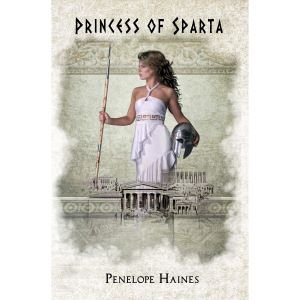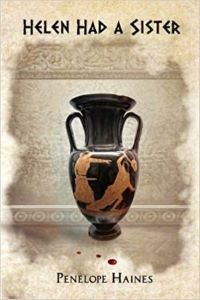
Interview with Penelope Haines by Anastasia Bakogianni
AB: What first drew you to ancient Greece and its stories? Incidentally, are you by any chance named after Penelope, queen of Ithaca?
PH: Yes, I am named after Ithaca’s queen! My father loved Greek literature and the Classics. When I was a child, he read me stories from classical mythology rather than fairy stories. When I was seven years old, we took a family holiday to Greece and the islands, where we saw many of the sites associated with the Greek gods and goddesses and ancient history. It made ancient Greece very real to me, and it has remained a life-long interest.
AB: What inspired you to make Clytemnestra the protagonist of your novel? In classical myth and Greek tragedy, the queen of Mycenae is portrayed as a stereotypical "bad" wife. While her husband Agamemnon is away fighting in the Trojan War, Clytemnestra takes his enemy Aegisthus as her lover. Even more damning, upon his return she helps her paramour murder the rightful king and usurp his power.
PH: I read 'The Iliad' and 'The Odyssey' sometime in my early teens and then reread them when I did a Classics course at university. I was intrigued by the relationship between the three queens in the saga – how closely intertwined their families were, and how each woman was allotted a very clear role: Helen the temptress, Penelope the faithful, patient wife, and Clytemnestra the murderous adulteress. Of the three, I felt drawn most to Clytemnestra’s story.

AB: Your title reminds us that, before she married, Clytemnestra was born a princess of Sparta. We tend to associate her more with Argos/Mycenae rather than her native city. This is partly because our ancient sources focus on the murder of her husband, but you begin your story with Clytemnestra’s girlhood in Sparta – tell us more.
PH: Sparta’s culture was unique in the ancient Greek world. It became famous for having the best soldiers in Greece, a city where both boys and girls were educated, learned music and dancing, and exercised in such sports as running, wrestling, throwing the discus and javelin. Girls had a good deal more freedom in Sparta than elsewhere in Greece, where women were much more secluded. It was also usual for Spartan girls to marry later than in other Greek city-states. The Spartans believed that fit, healthy, active young women were more likely to produce strong children. Their system of education was the inspiration, centuries later, for the Hitler Youth movement. Following the Spartan model, German young men and women were brought up to be fiercely loyal, unquestioning citizens, with great emphasis placed on health, exercise, war games and a common identity. This is but one example of the Nazis’ disturbing appropriation of ancient Greek culture.
In my novel, I thought it important for the arc of Clytemnestra’s story to establish from the beginning that she was no shrinking violet. Agamemnon knew this about his prospective bride, because he was a guest at Sparta’s court when he fled Mycenae. He might well have met Clytemnestra when she was a young girl. If he expected her to tolerate her daughter’s murder and not take her revenge, he was extraordinarily unaware of the woman he married.
AB: What about her arguably even more famous sister, Helen of Sparta/Troy? What are your views on this pair of adulterous sisters? What do their stories reveal about ancient Greek attitudes to women? Can they help us address urgent gender questions today, and if so how?
PH: The roles assigned to Helen and Clytemnestra are very specific in our ancient sources. Helen is the ultimate trophy wife. There is fierce competition for her hand in marriage. Then Helen abandons her husband, humiliating him in the most public manner imaginable, shacks up with Paris, causes a war that lasts for ten years, but Menelaus still forgives her and takes her back. She is a fascinating study of someone who understands the power of sexual attractiveness and uses it as a weapon, seducing those who had every right to judge her harshly.
Helen’s casual betrayal of her husband caused infinitely more damage to a larger number of innocent people than her sister’s murder of one man. Logically, her punishment should have been harsher, which in itself is telling. However, the glamour that surrounds her protects her from the consequences of her actions. It is interesting that the ancient Greeks were just as susceptible to this power and its manipulation as we are today. We see examples of this in our own world, when celebrities, socialites and film stars are held to a rather different set of rules than the rest of us.
In ancient Greek tragedy, Clytemnestra is a very different type of woman. Powerful in her own right, she assumes "masculine" traits when she takes upon herself the duty to avenge her daughter’s death. She views Iphigenia’s sacrifice as a deliberate act of murder, and is the primary force behind the plot to kill Agamemnon.
This one decision puts her at odds with ancient Greek values and traditional views of how a good ancient Greek wife should behave. By these standards, her crime is so heinous that is possible for her son to feel justified in murdering her. Orestes feels that he has to avenge his father even at the cost of matricide. In our ancient sources, it is clear that he views this as his duty, even though he knows that the Furies will exact a terrible penance for his killing of his mother.
Clytemnestra’s daughter Electra is also fascinating, but in a different way. In modern terms, we can argue that although a powerful, independent woman brought her up, she chose to align herself with her father and brother. In that respect, she takes on a more traditional female role.
The ancient Greeks placed a great deal of importance on being remembered, on leaving behind a great reputation. It is therefore hardly surprising that Clytemnestra has had so much bad press down the centuries. Our ancient male authors focus on her affair with Aegisthus turning her into the stereotypical murderous, adulterous "bad" wife. Speaking personally, this portrayal does not seem to me to do justice to the complexity of the character. However, her need to take revenge for the deliberate murder of Iphigenia struck me as psychologically compelling.

AB: What tools does a modern author need to use to make ancient characters like Clytemnestra "speak" to modern audiences? Are there any particular ways in which you sought to make her accessible to your readers?
PH: I had a lot of trouble with this aspect of the novel. You can argue that human nature has not changed much over the centuries. It is why we can still enjoy ancient drama. However, cultural norms have changed, so as a writer it is my job to decide how much information to include and what to leave out. My goal is to make ancient characters accessible to a modern audience. My intended readership for this novel was young adults, so at the most basic level, I simplified and modernised some of the language, eliminating any thee's and thou's that might have hindered the flow of the plot. I also hoped that she would prove an interesting character for them, one they could relate to or at least sympathise with.
AB: Do you have any plans to set any more novels in ancient Greece? Is there another favourite Greek story that you would like to adapt in the future?
PH: I have often thought Antigone would make a great heroine for modern times – particularly if the story was transported into a modern political setting. Antigone’s uncompromising sense of duty, which forces her into civil disobedience, is an aspect I would like to address in our current political, social and cultural context, particularly as she is such a strong female character. Who knows – one day I might attempt it!